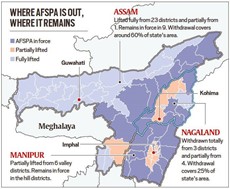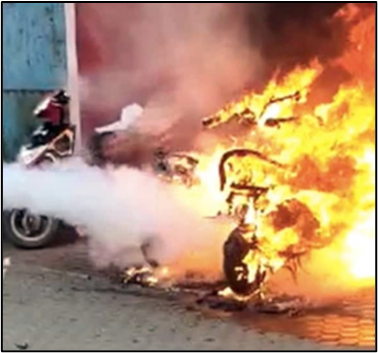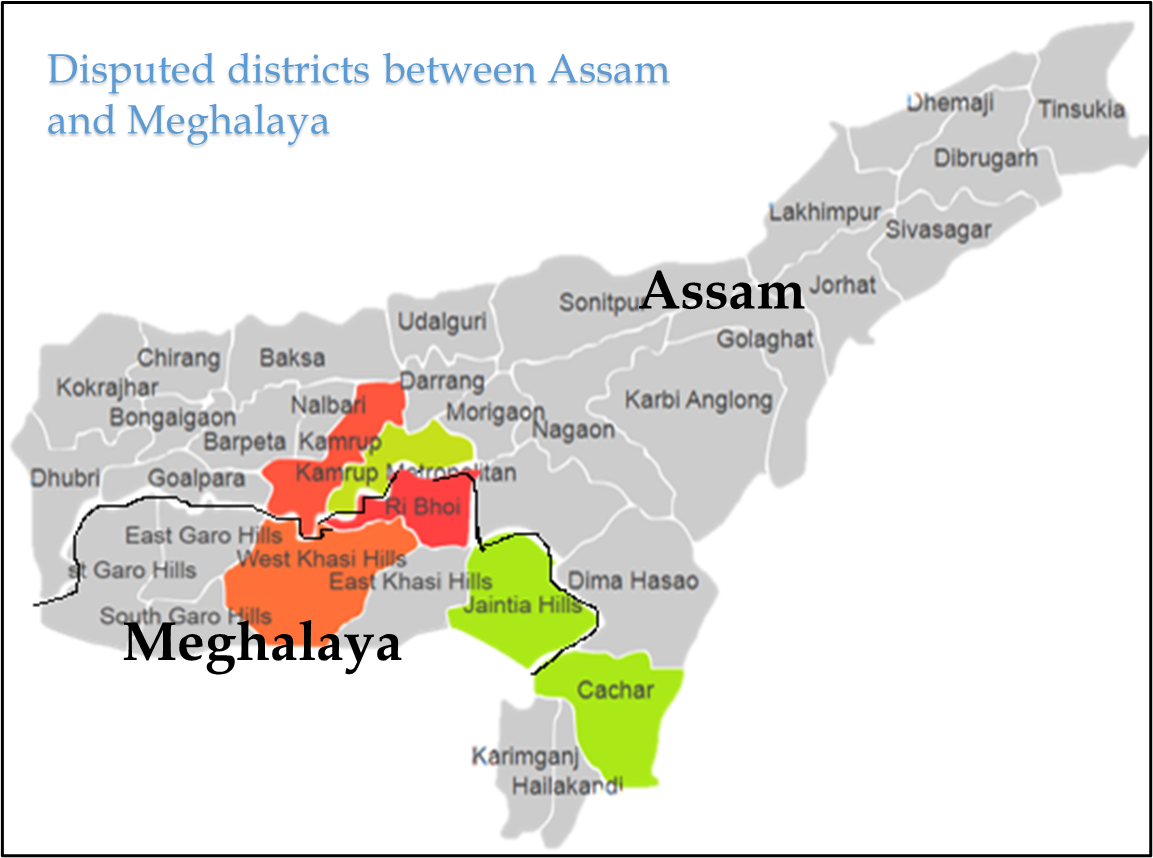Tuesday, 29th March 2022
Microplastic in Blood
In News
Microplastic pollution has been detected in human blood for the first time, with scientists finding the tiny particles in almost 80% of the people tested.
About Microplastics:
- Plastic debris, tiny fragments or fibres that are less than five millimeters in length are called “microplastics.” They are often invisible to the human eye.
- They are light enough to be transported by the wind over large distances and hence are known to be very mobile.
- Due to their size, it becomes difficult to ascertain the extent to which they have invaded our planet and the bodies of its living things.
- There are primary and secondary sources of microplastics.
- Primary sources are those where plastic has been crafted in tiny pieces – like plastic pellets or tiny beads that are 2-5 mm wide, made from polyester. Pellets are a common raw material in the plastic industry to manufacture many other larger plastic products, like plastic bags and containers. Microbeads are found in several personal care products including face scrubs, and paint.
- Secondary sources of microplastics include plastic bags, bottles and almost every other plastic object that breaks down into smaller pieces over time.
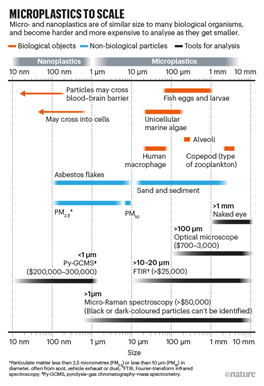
Microplastic in blood
- The recent study that found microplastics in the human blood conveys that about half of these were PET (polyethylene tertraphthalate) plastics, which is used to make food grade bottles.
- Overall, the study found four of the commonly used plastic polymers namely polyethylene tetraphthalate (PET), polyethylene (used in making plastic carry bags), polymers of styrene (used in food packaging), poly (methyl methylacrylate).
- The size of the particles that the group looked for was as small as about 700 nanometres (equal to 0.0007 millimetres).
- They found in each donor, on average, 6 microgram of plastic particles per milli litre of blood sample.
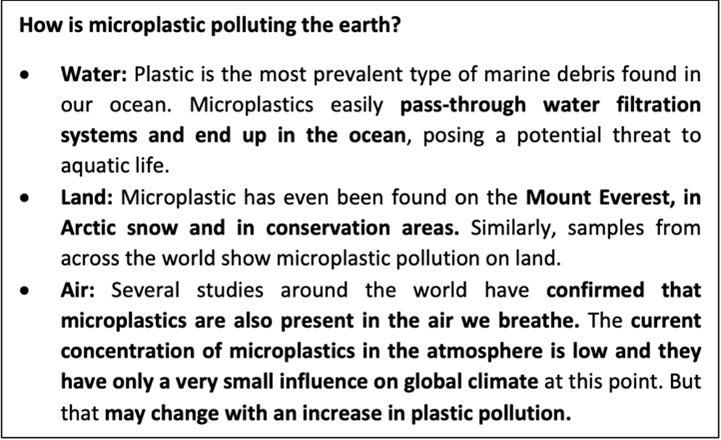
Health impact of microplastics
- No published study has yet directly examined the effects of plastic specks on people but there are certain possibilities.
- If they’re small enough to enter cells or tissues, they might irritate just by being a foreign presence — as with the long, thin fibres of asbestos, which can inflame lung tissue and lead to cancer.
- There’s a potential parallel with air pollutants PM10 and PM2.5, known to deposit in the airways and lungs. High concentrations of such particles can damage respiratory systems. But PM10 levels are thousands of times higher than the concentrations at which microplastics have been found in air. The larger microplastics are more likely to exert negative effects, if any, through chemical toxicity.
- There is a worry accumulation in human organs of such debris. A study conducted on lab mice showed found that microplastics around 5 µm across could stay in the intestines or reach the liver causing damage.
- Microplastics in the environment might attract chemical pollutants and then deliver them into animals that eat the contaminated specks.
- Marine organisms swallow plastic specks of no nutritional value, and don’t eat enough food to survive.
Sources:
- We Are Made of Plasticstuff: Scientists Find Microplastics in Human Blood:
- We Are Made of Plasticstuff: Scientists Find Microplastics in Human Blood:
- Detecting microplastics in human blood:
- What are microplastics?:
- Microplastics are everywhere — but are they harmful?:
- Analyze this: Microplastics are showing up in Mount Everest’s snow
- Microplastics are in the air we breathe and in Earth’s atmosphere, and they affect the climate:
Merchandise Export of India
In News
India has recently achieved its merchandise export target of $400 billion for FY22.
About the News
- The merchandise exports had risen by 37% to USD 400.8 billion in 2021-22 against USD 292 billion in 2020-21.
- The target achieved is backed by strong and healthy performance by sectors such as petroleum products, precious and semi-precious stones, engineering goods, drugs and pharmaceuticals.
- Significance: India’s exports of goods and services as percentage of GDP was approximately 21.7% in 2021-22. Higher export demand creates access to diversified market opportunities, increases availability of foreign exchange, and raises job opportunities especially in labour-intensive export sectors, powering economic growth.
Policy steps that led to the exports’ boost:
- India’s Foreign Trade Policy: India’s updated Foreign Trade Policy was launched in 2015 that rationalized previous export promotion schemes and introduced new ones.
- The government had opened a dedicated division for unified development of the logistics sector.
- Launched an interest equalization scheme to facilitate cheaper credit to exporters, unveiled an agriculture export policy,
- Classified districts as export hubs by identifying products with export potential and addressing bottlenecks, and reached out to potential exporters, especially from the MSME sector, and mentored them.
- PLI scheme and exports: The Production Linked Incentive (PLI) scheme that was introduced to boost domestic manufacturing and exports by incentivising incremental sales to make India competitive in global markets has significantly contributed in achieving this target.
- The scheme has been open for sectors such as textile products, automobile and auto components, drugs, mobile phone manufacturing and specified electronic components.
- It aims to boost manufacturing capabilities and encourage export-oriented production. For instance, the scheme is expected to raise mobile phone exports to $5.5 bn in FY22 from $3.16 bn in FY21.
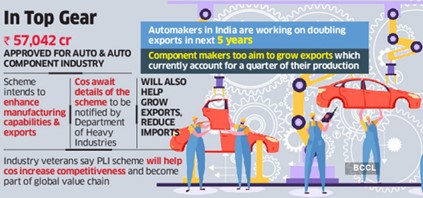
Trend in merchandise export:
- Before this year’s $400 billion milestone, merchandise exports reached $331.02 billion in 2018-19.
- Services exports for April-February 2021-2022 have also shown a rise of 22.49% vis-à-vis April-February 2020-21.
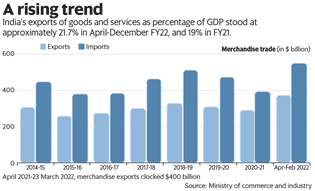
Source:
- What $400 bn merchandise exports mean for the economy
- India crosses USD 400 billion goods exports target for the first time
Image source:
Criminal Procedure (Identification) Bill, 2022
In News
Ministry of Home Affairs (MHA) has recently introduced the Criminal Procedure (Identification) Bill, 2022 in Lok Sabha to repeal the Identification of Prisoners Act 1920.
About the News
- The bill authorises law enforcement agencies to collect, store and analyse physical and biological samples of convicts and other persons for the purposes of identification and investigation in criminal matters.
- The bill is seen as a necessity to expand the "ambit of persons" and help investigating agencies gather sufficient legally admissible evidence and establish the crime of the accused person.
- At present, advanced countries across the globe including USA and France are relying on new "measurement" techniques for reliable results in crime proceedings.
What are the major highlights of the Criminal Procedure (Identification) Bill?
- Measurements: It will include finger impressions, palm-print and foot-print impressions, photographs, iris and retina scan, physical, biological samples and their analysis, etc.
- Role of NCRB: The bill will empower the National Crime Records Bureau (NCRB) to collect, store and preserve the record of measurements and for sharing, dissemination, destruction and disposal of records.
- Role of Magistrate: The bill seeks to empower a Magistrate to direct any person to give measurements. He can also direct law enforcement officials to collect fingerprints, footprint impressions and photographs in the case of a specified category of convicted and non-convicted persons.
- Role of Police: Police or prison officers will be able to take measurements of any person who resists or refuses to give measurements. The Bill also authorises police to record signatures, handwriting or other behavioural attributes referred to in section 53 or section 53A of the Code of Criminal Procedure, 1973, for the purposes of analysis.
- Preventive detention: As per the Bill, any person convicted, arrested or held under any preventive detention law will be required to provide "measurements" to a police officer or a prison official.
- Record storage: The record of these measurements will be retained in digital or electronic form for a period of seventy-five years from the date of collection.
- Destruction of records: The records are to be destroyed in the case of any person who has not been previously convicted of an offence punishable under any law with imprisonment for any term, and had his/her measurements taken according to the provisions of the Act.
- Role of courts: The court or Magistrate, for reasons to be recorded in writing, can direct agencies to maintain the records if he/she is released without trial or discharged or acquitted by the court, after exhausting all legal remedies.
- Federal balance: As per the bill, any state government of Union Territory administration may notify an appropriate agency to collect, preserve and share the measurements of a person of interest in their respective jurisdictions.
- Refusal to comply: Resistance to or refusal to allow the taking of measurements under this Act shall be deemed to be an offence under section 186 of the Indian Penal Code (IPC).
What are the major issues?
- Violates Fundamental Rights: The bill is seen as violation of Article 20(3) of the Constitution which secures the right of an accused against Self-incrimination. Experts have raised concerns as bill militates the right to life and privacy enshrined under Article 21 of the constitution.
- Right to be Forgotten: The Bill permits that record of measurement may be retained for 75 years and thus in a way violates the Right to be Forgotten, recognized by the Supreme Court in the case of Justice KS Puttaswamy v. Union of India.
- Possibility of misuse: Words "biological sample and their analysis" under the bill could extend to Narco-analysis and brain-mapping and if it is made coercive in terms of bill, it becomes violative of the human and fundamental rights.
- Rights of prisoners: The implied use of force to take measurements violates the rights of prisoners, laid down by the Supreme Court in catena of judgments including AK Gopalan v. State of Madras, Kharak Singh State of UP, Charles Sobraj v. Jail Superintendent, Sheela Barse v. State of Maharashtra and Pramod Kumar Saxena v. Union of India.
- Against cardinal principles of law: The bill has been criticised for being opposed to the cardinal principle of criminal jurisprudence that nobody is found guilty until proved in court of law.
- Custodial violence: Given the rate of custodial violence in Indian prisons, there is a high risk of "forceful measurement", resulting in life long stigmatization and grave violation of human rights.
- Data privacy: In the absence of a Data Protection statute, this bill might do more harm than good as there is little empirical data supporting the accuracy of criminal profiling coupled with lack of adequate technology and the grave margin of error.
- Fear of political prosecution: Apprehensions have been raised about misuse of the Bill, especially in light of the exemption from prosecution for acts done under the Act, intended in good faith.
Sources:
Terra Cotta Warrior
On March 29, 1974, the first in an extensive collection of terra-cotta warriors was discovered in Xian, China. Local farmers came across pieces of a clay figure, and these shards led to the discovery of an ancient tomb, vast in its size and number of artifacts. The tomb was ordered to be built by Qin Shi Huangdi, the first emperor of China. The portion containing his remains are still unexcavated. In the part of the tomb that has been excavated, thousands of sculptures of horses and warriors in full armor stand in battle formation. The warriors are life-size, with most about two-meters (six-feet) tall. The sculptures weigh up to 272 kilograms (600 pounds) each. Each warrior has unique characteristics—facial features, hairstyle, clothing, and pose.
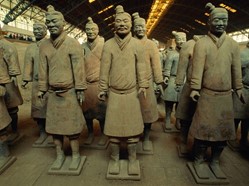
Source:
One Rank, One Pension for defence forces
In News
The Supreme Court upheld the central government’s decision on One Rank, One Pension (OROP) for defence forces saying that it did not find any constitutional infirmity in the manner in which it is being implemented.
What is OROP?
- OROP implies that uniform pension be paid to the Armed Forces Personnel retiring in the same rank with the same length of service regardless of their date of retirement.
- Before implementation of OROP, the computation of pension was linked to the pay drawn by the personnel in a particular pay scale/ pay band at the time of his/her retirement.
- Pay scales are revised to the higher side generally on the recommendation of Pay Commissions.
- As such, the personnel retiring after the revision of the pay scales got more pension than those who had already retired. Hence, the gap remained in the pension of the past and present retirees.
- OROP aims to bridge the gap between the rate of pension of the current pensioners and the past pensioners at periodic intervals.
Important Features of OROP
- Pension of past pensioners would be re-fixed based on pension of retirees of calendar year 2013 and the benefit will be effective from 01.07.2014
- Pension will be re-fixed for all pensioners on the basis of the average of minimum and maximum pension of personnel retired in 2013 in the same rank and with same length of service.
- Pension for those drawing above average shall be protected.
- Arrears will be paid in four equal half yearly instalments. However, all the family pensioners including those in receipt of Special/Liberalized family pension and Gallantry award winners shall be paid arrears in one instalment.
- Pension would be re-fixed every 5 years.
What are the Objections that have been raised against the OROP?
- In 2016, the Indian Ex-Servicemen Movement (IESM) had moved the Supreme Court seeking implementation of one rank one pension scheme in a fair manner with an automatic revision on annual basis instead of the stated periodic review of once in five years.
- They submitted that the government had altered the initial definition of OROP from “automatic bridging”, to “periodic bridging at intervals”.
- The petition had contended that this was arbitrary and unconstitutional under Articles 14 and 21 and called the policy essentially becoming “one rank multiple pensions.”
- The IESM had also alleged that OROP had led to the creation of a separate class among personnel equally situated in “rank” and “length of service”.
- The Union government had told the Supreme Court in February that both “same rank” and “same length of service” are necessary conditions, that need to be fulfilled simultaneously for availing of OROP benefits.
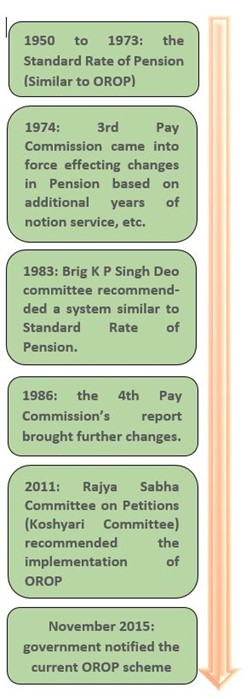
Court’s Ruling
- The Supreme Court said that one rank, one pension (OROP) in the armed forces is a policy decision of the government, is not arbitrary and suffers from no constitutional infirmity.
- It said that there’s no legal mandate that pensioners who hold the same rank must be given the same pension.
- It directed that the pending re-fixation exercise of OROP, which has not been done due to pendency of matter before the court after the expiry of five years, should be carried out from July 1, 2019, and arrears be paid to the pensioners in three months.
- The court held that since the OROP definition is not arbitrary, it is not necessary for it to undertake the exercise of determining the financial implications of the scheme.
- The SC said that the policy only seeks to protect those who retired before 2014 since the last drawn salary of the prior retirees might be too low and incomparable to the pay of the 2014 retirees.
- Further, the court refused to accept the petitioner’s stand that re-fixation of pension after a gap of five years would leave them at a great disadvantage.
- The constitutional parameters of the scheme, nevertheless, are yet under judicial review.
Benefits of OROP:
- Correcting a historic wrong: The Armed Forces of the Union are 'rank-based structure' organisations. The ex-servicemen are associated with their rank even after their retirement and death. Gradually since 1950, the pension for armed forces was reduced from 90% to 50% of their last pay drawn causing much variations even between same ranked individuals.
- Equitable benefits as compared to civilians: Armed forces have to retire early as a matter of policy of Government which causes loss of earnings to them vis a vis the benefits given by successive Pay Commissions which could have accrued to them if they were made to retire at the normal retirement age of sixty.
- There is absence of lateral absorption in government jobs after service. Thus, OROP can compensate for this loss.
- Automatic revision every 5 years: OROP guarantees pay revision every five years even for ex-servicemen. This is important for the welfare of defence personnel in an inflationary economy.
- Moral support: OROP has been a demand of the Defence personnel for a very long time with various Central Government appointed Committees recommending its implementation since 1973. By accepting this long-pending demand, the government has ameliorated the aggrieved retired servicemen of the defence forces.
Problems with implementation:
- Demands from other sections: The retired officers from para-military forces, particularly the Border Security Force have also spoken for one rank one pension. Similarly, there is a chance that other paramilitary factions may demand something similar.
- Increased burden on the exchequer: With periodic revision of pension of ex-servicemen, the share of Government expenditure on the same will increase. It may manifest as a burden on the economic situation of the country.
- Possibility of higher salary to retired than serving: With frequent revisions, the pension of retired personnel may trump that of the serving at the same rank.
- Challenges to the administration: For evaluating the rates and paying the pension efficiently, the records are needed. However, these records must be re-traced as some of the records are missing. Records date back to post-independence times, and it is possible that with time certain records have been lost.
Way forward
- Resettlement of ex-servicemen is a complex socio-economic process involving satisfactory provision of pension and resettlement facilities. Therefore, it is important that collective efforts need to be undertaken by all stakeholders involved in resettlement of ex-servicemen.
- Such resettlement, in addition to pensions may include laterally placing them in suitable civilian employment with the government or arranging for entrepreneurship ventures for the willing ex-servicemen in lieu of a job.
- This would benefit the ex-servicemen, government and the society on three counts:
- Firstly, the ex-servicemen will get continuous employment till their age of superannuation equivalent to that of civilian government employees.
- Secondly the government can avail the services of such trained human resources by incurring only a marginal expense on the salary bill.
- Finally, the economy and the society as a whole will be immensely benefitted as the expertise of the versatile veterans will be utilised to the possible extent for the development of the country.
Question: Though OROP tries to resolve the concerns related to pension of the defence forces, it will have its share of challenges. Elabotate.
Sources:
- Supreme Court upholds govt’s decision on One Rank, One Pension for defence forces:
- Explained: The rank-pension case:
- OROP:
- One Rank, One Pension Is Govt’s Policy Decision, Suffers From No Constitutional Infirmity: SC:
- SC pulls up Centre on OROP: Examining the policy and why the matter has reached apex court:
- One Rank One Pension: SC upholds scheme for defence forces:
- OROP: Ethics and Management Implications in Resettlement of Defence Service Veterans in India:
- BENEFITS OF OROP SCHEME:
- Ex-Servicemen move SC for 'fair' OROP working, annual revision:
- HUNDRED AND FORTY-SECOND REPORT ON PETITION PRAYING FOR GRANT OF ONE RANK ONE PENSION TO THE ARMED FORCES PERSONNEL:
- Current status of one rank one pension clause:
Fire at Ghazipur Landfill
This is image of flames and smoke rising from a fire at Ghazipur Landfill recently. A massive fire broke out at the dumping yard of east Delhi's Ghazipur area on 28th March, 2022 leading to a huge cloud of smoke enveloping the region and neighbouring areas. Fires at the landfill are known to worsen pollution levels in the area. Such incidents had been reported from the Ghazipur landfill in the past too, which indicates “lack of measures taken and vigilance observed by EDMC to prevent such episodes. Approximately 2,000 tonnes of garbage is dumped at the site every day. According to the report of The Energy and Resources Institute organization, Delhi has suffered a loss of Rs 450 crore due to the three garbage mounds.
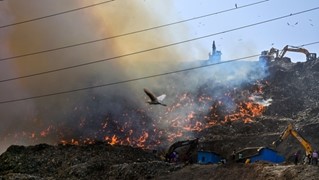
Source:
Bucharest Nine
- Context: The Bucharest Nine (B 9) has recently rejected the Russian claim about the eastward “expansion” of North-Atlantic Treaty Alliance organisation (NATO).
- The “Bucharest Nine” or Bucharest Format is a group of nine NATO countries in Eastern Europe that became part of the US-led military alliance after the end of the Cold War.
- Abbreviated as the B9, it was founded in 2015, and takes its name from Bucharest, the capital of Romania.
- It offers a platform for deepening the dialogue and consultation among the allied states, to articulate their specific contribution to the ongoing processes across the North-Atlantic Alliance, with solidarity and indivisibility of the security of the NATO Member States.
- Romania, Poland, Hungary, Bulgaria, the Czech Republic, Slovakia, and the three Baltic republics of Estonia, Latvia, and Lithuania comprise the B9.
- All members of the B9 are part of the European Union (EU) and the NATO.

Source:
- Explained: Who are the Bucharest Nine, countries on NATO’s eastern flank?
- President says an honest Europe must halt aggression
Image source:
Web3
- Context: The demand for Web3 talent has surged as internet moves to next stage.
- Web3 is an idea for a new iteration of the World Wide Web based on blockchain technology, which incorporates concepts such as decentralization and token-based economics.
- It was originally coined the Semantic Web by Tim Berners-Lee, the Web’s original inventor.
- Web3 is believed to provide increased data security, scalability, data security, scalability and privacy for users and combat the influence of large technology companies.
- However, experts have raised concerns about a decentralized web, citing the potential for low moderation and the proliferation of harmful content, centralization of wealth to a small group of investors and individuals or loss of privacy due to more expansive data collection.
- Companies developing apps and Web3 platforms will require blockchain developers, machine learning specialists, app developers, front-end and back-end developers, user interface (UI) and user experience (UX) designers, data analytics professionals and content writers.
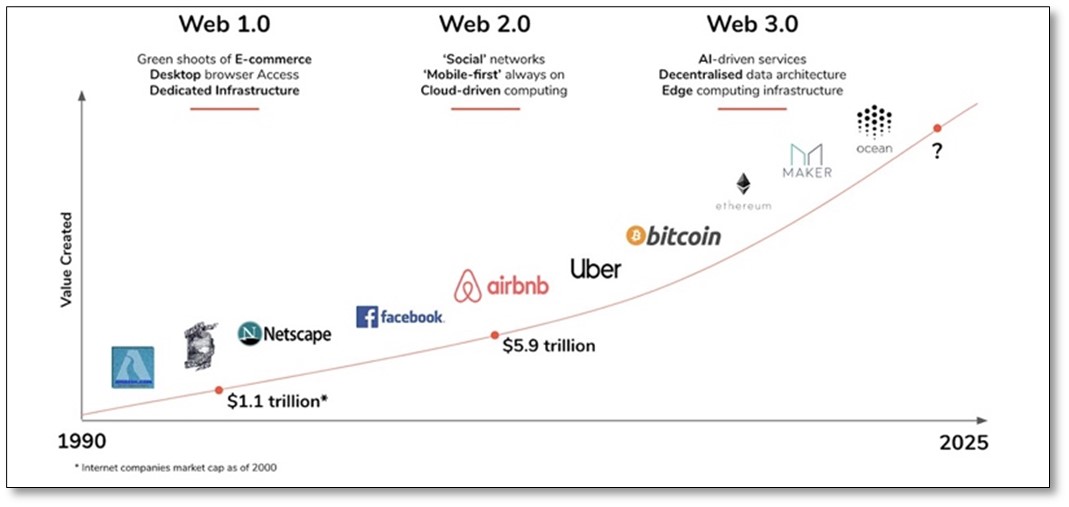
Source:
Image source:
Great Barrier Reef
- Context: A recent study has noted that Australia's Great Barrier Reef has been suffering "mass bleaching" as corals lose their colour under the stress of warmer seas.
- The Great Barrier Reef is the world's largest coral reef system, stretching for more than 2,300 kilometres (1,400 miles) along the northeast coast of Australia.
- It is one of the seven wonders of the natural world, and it contains an abundance of marine life and comprises of over 3000 individual reef systems and coral cays and literally hundreds of picturesque tropical islands with some of the world’s most beautiful sun-soaked, golden beaches.
- It is larger than the Great Wall of China and the only living thing on earth visible from space.
- The Reef 2050 Long-Term Sustainability Planis the Australian and Queensland Government’s overarching framework for protecting and managing the Great Barrier Reef by 2050.
- Recently, the UNESCO World Heritage Committee has recommended that the Reef should be added to a list of “in danger” World Heritage Sites.
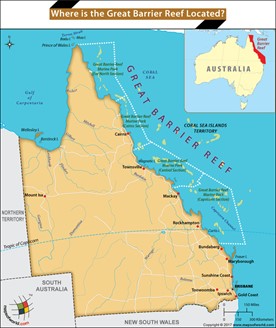
Source:
Image source:
Malabar Rebellion
- Context:The Indian Council for Historical Research (ICHR) has deferred its decision on a recommendation to remove the Malabar Rebellion martyrs from the list of India’s freedom fighters.
- Malabar rebellion, also known as the Moplah riots was an uprising of Muslim tenants against British rulers and local Hindu landlords.
- It was supported by Congress leaders like Gandhi ji.
- The rebellion turned violent after the leadership was passed on to the locals.
- It was an armed revolt led by Variyamkunnath Kunjahammed Haji.
- The uprising, which began on August 20, 1921, went on for several months marked by bloodshed (estimated to have lost 10,000 lives, including 2,339 rebels).
- The trigger of the uprising came from the Non-Cooperation Movement launched by the Congress in 1920 along with the Khilafat agitation.
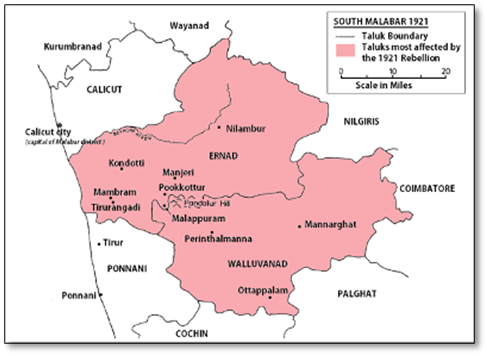
Source:
- Decision on Malabar Rebellion martyrs deferred
- Explained: Why does the 1921 Malabar rebellion still court controversy?
Image source:
The era of an unemployed India: TH
Essence: Overqualified youth aspiring for middle and lower rung government jobs contradicts the government claims of employment generation. The National Sample Survey Office (NSSO) reported a 6.1% unemployment rate in 2017-18, the worst in over four decades. The situation deteriorated further with the covid-19 induced economic lockdown and subsequent job losses.
Reasons for overqualified people applying for lower rung government jobs are high job insecurity (easy hire and fire), poor basic pay, and long hours of work in the private sector, reduced expenditure by the state on social sector and contractualisation and outsourcing of several substantative posts. Deregulation of labour market along with the push for privatisation of the public sector is leading to periodic unemployment of higher skilled workers and pushing more qualified youth to crowd lower rung government jobs.
For the fulfilment of dignified employment, the youth need to be guaranteed access to the basics — education, health and livelihood.
Why should you read this article?
- To know about the unemployment scenario, backed by data and examples, in India.
- To understand the reasons behind high demand for government jobs and their consequences.
Source:
Unlocking the potential of platform cooperatives: HBL
Essence: Platform cooperatives are member-owned businesses that use a website, mobile application, or protocol to connect to one another or to organize services. They foster solidarity and lead to financial benefits of many unlike conventional systems which benefits few capitalists. It is hoped to lead to communal and economic resilience.
The author points out that a tough challenge these new age cooperatives are going to face is in aligning the values of all their owner members. To make a real difference, Platform cooperatives should collaborate with tech services providers, respect digital privacy of customers and should scale up their business.
Why should you read this article?
- To know the meaning of platform cooperatives.
- To understand the potential of such cooperatives, understand challenges which they may face and steps which should be taken to address these.
Source:
Common University Entrance Test won’t solve the real problems: IE
Essence: The editorial summarizes advantages of conducting the CUET for undergraduate entrance but goes beyond to highlight the shortcomings and looks into fundamental reformations in education. Conducting a standard exam for students from various boards with uncommon syllabi, creating objective and value-neutral tests, removing the hurdle of writing multiple entrance test, eliminating the scope of inflated cut-offs are some advantages of conducting CUET.
But this mode of selection is appropriate if we qualify mathematical objectivity to judge one’s mental aptitude and domain knowledge. This would make examination book-centric, education exam centric and learning rote centric. Strategic learning in the name of coaching institutes would prosper, and students would turn into exam-warriors. CUET would join the league of NEET and JEE and students would have increased stress and anxiety.
The MCQ’s objectivity diminishes creative exploration, interpretation-based learning (hermeneutics), and reflection. While the exam process might not go beyond NCERT textbooks, the individual’s learning with wonder, creativity, joy, etc. needs real transformation in the form of providing autonomy to academic institutions, recruitment of spirited teachers, life-reinforcing pedagogy, and valuing uniqueness of each child.
Why should you read this article?
- To understand the significance and shortages in CUET.
- To know the possibilities for a student beyond objective tests.
Source:
Barefoot College
Background
Sanjit Roy, also known as ‘Bunker’, founded the Social Work and Research Centre (SWRC, popularly called as the Barefoot College in Tilonia village of Ajmer.
About Bunker Roy
- A graduate from St. Stephen’s College, Delhi, he was inspired by Jayaprakash Narayan and moved by the Bengal famine.
- Roy dug wells as an unskilled labour to test his commitment before going headlong into social service, driven by the Gandhian principles of simplicity, austerity and accountability.
- He identified traditional knowledge skills and wisdom that were not recognised, underutilised and not applied. The aim should be to look for community solution.
- He worked on the reversing the migration trend and providing dignified work opportunity to the people in the native places.
- SWRC has been successful in training illiterate village women to become solar engineers. Popularly called Solar Mamas, hundreds of women from African countries and Afghanistan have also been trained in Tilonia as part of the External Affairs Ministry’s initiative.
- Roy, a Padma Shri awardee, had also petitioned against a Rajasthan government emergency order that allowed female famine relief workers be paid less than male workers.
- The Barefoot College is working towards uplifting the craftsmanship of the local people and bringing a better livelihood.
Quote: “Vocational education programs have made a real difference in the lives of countless young people nationwide; they build self-confidence and leadership skills by allowing students to utilize their unique gifts and talents”.-Conrad Burns
Source:
Share the article
Get Latest Updates on Offers, Event dates, and free Mentorship sessions.

Get in touch with our Expert Academic Counsellors 👋
FAQs
UPSC Daily Current Affairs focuses on learning current events on a daily basis. An aspirant needs to study regular and updated information about current events, news, and relevant topics that are important for UPSC aspirants. It covers national and international affairs, government policies, socio-economic issues, science and technology advancements, and more.
UPSC Daily Current Affairs provides aspirants with a concise and comprehensive overview of the latest happenings and developments across various fields. It helps aspirants stay updated with current affairs and provides them with valuable insights and analysis, which are essential for answering questions in the UPSC examinations. It enhances their knowledge, analytical skills, and ability to connect current affairs with the UPSC syllabus.
UPSC Daily Current Affairs covers a wide range of topics, including politics, economics, science and technology, environment, social issues, governance, international relations, and more. It offers news summaries, in-depth analyses, editorials, opinion pieces, and relevant study materials. It also provides practice questions and quizzes to help aspirants test their understanding of current affairs.
Edukemy's UPSC Daily Current Affairs can be accessed through:
- UPSC Daily Current Affairs can be accessed through Current Affairs tab at the top of the Main Page of Edukemy.
- Edukemy Mobile app: The Daily Current Affairs can also be access through Edukemy Mobile App.
- Social media: Follow Edukemy’s official social media accounts or pages that provide UPSC Daily Current Affairs updates, including Facebook, Twitter, or Telegram channels.


